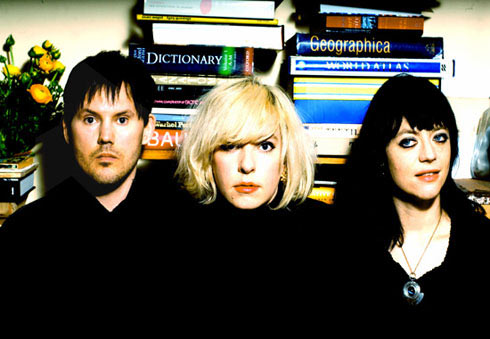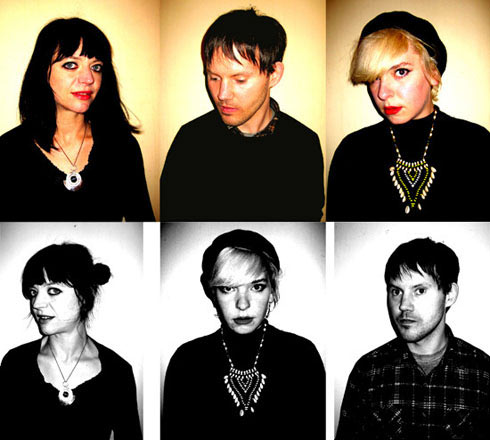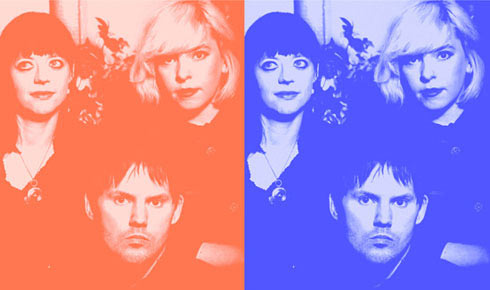Forever Is A Long Time


 Words:Douglas Lance Gibson Images: Love Of Diagrams
Words:Douglas Lance Gibson Images: Love Of Diagrams
If you were to play Love Of Diagram’s first album, The Target Is You, alongside their latest offering, Nowhere Forever, there’s a good chance that the uninitiated wouldn’t recognise that they were created by the same band. But for those who have watched the band develop from their stark, angular instrumental beginnings to their current texture rich approach, the progress makes a lot more sense. This is a band that practically learnt how to sing in public, and with each release, their growth as songwriters has become apparent.
On their third album, Nowhere Forever, Love Of Diagrams deliver their most confident songwriting yet. The album automatically feels familiar and immediate, a cohesive document that captures the band’s current feel perfectly. Doug Gibson sat down with guitarist Luke Horton to find out how they did it…
Doug Gibson: For the recording of Nowhere Forever, you basically recorded the whole album as demos before you went across to America to do the studio recordings. Would you ever produce a whole album yourself?
Luke Horton: Do you mean record it at home and do it all ourselves?
DG: Yeah, as another way of keeping control.
LH: I don’t think we’ve got the technical capabilities to make a record sound really good. Also, we want good live sounding drums, and we want those things that give a “band playing in a room” sense to it, and I think you have to be a very skilled technician to pull off those sounds. If we were making very lo-fi music and the drums could just be this distorted thing in the background, I could probably pull off stuff that I was happy enough to use. That said, no one has ever produced our records, we’ve always been completely in charge of all the sounds and the mixes and all that stuff. We just work with people who are really talented engineers.
DG: So what was the impetus to go back over to America to record Nowhere Forever?
LH: We were talking to a few people for a little while about this record. Guy Picciotto, from Fugazi, we were talking to him for a while. He came to our show and he seemed to like the band and he was interested in doing it. He’s made a whole bunch of records with Ryan Hadlock, who made the record, and they work together as co-producers. They’ve made a few Blonde Redhead records together at Bear Creek. That was an exciting proposition but he just got really busy, playing guitar again in Vic Chestnutt’s band, then his wife was having a baby, so we just couldn’t work out when to do it. He just said to us, “You should just work with Ryan, because Ryan really does all the work. When we work together I’m there as an ideas person and co-producer. It’s Ryan’s studio and he knows what he’s doing. Just work with him.” So that’s how we ended up working with Ryan. We got a grant to do it, so that helped us to get over there. I guess, rather than doing it here, to go back to the States…well, there were so many great records coming out of Bear Creek and all the amazing vintage gear that Ryan had access to. It just seemed like a beautiful studio in a beautiful spot, sort of in these woods with these beautiful, old timber buildings. It was just a really nice place to go and make a record.
DG: At this point you already knew that Matador weren’t interested in releasing your next record?
LH: They told us pretty quickly after the release of the last one, Mosaic, that they wouldn’t be able to put out the next one. We spent some time in England and we were hanging out with a few from the Matador office there and got to know them really well. We came back to Australia and we got this email a week after coming back that the office had been closed down and that they just couldn’t afford to keep it running anymore. There were warning signs like that that sort of let us know that they were struggling a little bit. Matador are a part of Beggar’s Group, so they’ve got bosses, and I think a band from Australia just would have been that much of a harder sell. I guess we were probably a little delusional. I think we tried to convince ourselves that we didn’t have to be the next Interpol or whatever to stay on Matador. They’ve got smaller experimental acts on the label. The reality is the smaller bands on there are from Brooklyn or D.C. or whatever, they’re not from Melbourne. So for the amount of money it costs them to give us tour support and things like that, it’s just that much harder. All the bands that we know that do well in the States just tour constantly. So we’d just have to be keeping that up. We did really see some results, I felt like there was momentum building. By the time we did our last tour, there were a lot of audiences coming back to see us, people yelling out for certain songs, and we getting quite good crowds but I just don’t think that was reflected in CD sales, because people aren’t buying CDs as much as they used to. So, it was a tough time to be signed to an overseas label. Given a little bit longer, I think this record would have done a bit better, because the last one was a very raw, live sounding record. If we’d known that Mosaic was going to make or break us on the international level, then, you know…we made that record off our own bat and then Matador decided to pick it up, so we would have asked them for more money to go back and work on it. We were happy with it being a kind of document, as a live, rock, noisy record but we didn’t realise it was going to have those kind of expectations on it. Maybe we should have been less naïve and just got some smaller label to license that record and build it up that way, instead of being thrown in the deep end with someone like Matador. You learn from these things.
DG: You must still be pretty proud though?
LH: Yeah, it was a great achievement and it means we got over there and I think a lot more people know about us now than they would have if we didn’t have that experience. Every time we go back we are getting bigger audiences. It’s great to be able to go somewhere like New York or San Francisco or Boston or D.C. and have an audience there and I think that definitely had something to do with Matador, so there are positives about it.
DG: The aggression that I felt was apparent on your previous releases is less so on Nowhere Forever.
LH: I think that’s also to do with the recording process. Mosaic was eight days, and it was like a live set, and we were playing lots of fast songs. We played them really fast in the recording studio. We came back and listened to the record and were like, “Jesus Christ, we played that so fast.” So that was a product of having limited time and I guess being nervous about recording. And live, those songs were all really fast. The songwriting process for Nowhere Forever was so different. I think we’ve just got better at songwriting, and not every song has to be pedal to the metal. We’ve learned how to write slow songs, songs with different nuances that aren’t always full throttle. I think you need songs like that to make it an interesting experience all the way through.
Love Of Diagrams – Look Out (Right click and save to download)
DG: Also with the lyrics, on Mosaic the lyrics almost became slogans in the way they were structured and in their delivery, but with Nowhere Forever the lyrics seem less direct as well as being more personal in a way.
LH: I think because we were instrumental, we liked that aspect of the band, that songs weren’t overly explained. People had an emotional response to them. I don’t think we’re ever going to be a narrative-lyric driven band. In terms of musical ideas, we like repetition and playing with the dynamics of the repetition of certain things. I think that as a vocal idea, it was something that Antonia liked as well, just playing with a really limited amount of lines but playing with the nuances and dynamics in there. Lines being suggestive of stuff without spelling it out. But that said, I think this time around we tried to stretch our writing as well. Maybe because we spent a bit more time in recording at home, I got a chance to work on the lyrics a bit more. We still like the idea that we’re not spelling out stuff too much. I like things being open to different interpretations and yet not being nonsense lyrics. They mean very personal and often very specific things to us.
DG: When you compare Nowhere Forever to your back catalogue, it becomes apparent how with every subsequent release, you’ve added another layer. Where you started out as quite a sparse, minimal instrumental band you’ve now developed a rather sound-drenched epic style and the vocals have become a more significant factor in the band’s sound. Do you think you’re going to reach a saturation point?
LH: What do you mean?
DG: Well, you’re constantly adding, do you think you’ll keep adding or do you think you’ll reach a point where you’re like, “This is enough. Let’s start reducing, become more reductive.”
LH: Yeah, that’s an interesting way of looking at it, and I think that’s true. Basically I feel like, and a few reviews have sort of pushed this line of us reinventing ourselves…
DG: I don’t really see that as much.
LH: I’m glad you don’t, as I don’t really see that either. I understand where they’re coming from, because if they really only have Mosaic, which was something that we made in 2005, and then we made another record in 2008, of course there’s going to be a progression, we’re going to be exploring different things. For anyone that’s watched us as a live band over those years…
DG: Yeah, that’s what I’ve felt, as I’ve seen that come through in your live shows.
LH: Yeah, it’s a total, natural progression. We didn’t have any kind of ideas of changing our sound. We came home from touring a lot, and then we didn’t do much for a while, so – I record at home – I did home demos and explored sounds, tried different guitar pedals. So once you add these things, it does give a different feel to this material. We wanted to explore different sounds, so it definitely has a lot of new elements and different things we’re exploring, but if you put songs like ‘Lookout’ of this new record next to ‘The Pyramid’ off Mosaic, there isn’t a huge jump in sounds to me. But to answer your question, I guess, yeah, we might decide that we’ve done “wall of sound” guitars now, and we’ve really gone for the layered, textured sound, which was something that I really wanted to pull off. I really wanted to make an album that sounded like an album you’d listen to rather than a document of a live band, so that for me was trying to achieve different types of textures and guitar sounds, different layers. Something that you could listen to repeatedly and hear different stuff in. A lot of my favourite records have lots of guitars and lots of different sounds going on. I think we’re excited in exploring that, so I don’t really know what’s going to happen next. We’re writing a lot of songs and they’re in a similar vein to Nowhere Forever at the moment, but we might be interested in exploring a different dynamic.
For your chance to win a copy of Nowhere Forever just email [email protected]
More from Love Of Diagrams
Next Article: Rainoff Books: Let It Rain



